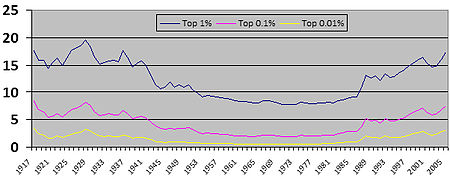Great Compression
[5] Economist Paul Krugman gives credit for the compression not only to progressive income taxation but to other New Deal and World War II policies of President Franklin D. Roosevelt.Krugman argues these explanations are more convincing than the conventional Kuznets curve cycle of inequality driven by market forces because a natural change would have been gradual and not sudden as the compression was.[6] Explanations for the length of the compression have been attributed to the lack of immigrant labor in the US during that time (immigrants often not being able to vote and so support their political interests) and the strength of unions, exemplified by Reuther's Treaty of Detroit—a landmark 1949 business-labor bargain struck between the United Auto Workers union and General Motors.Further, members of Congress in both political parties significantly overlapped in their voting records and relatively more politicians advocated centrist positions with a general acceptance of New Deal policies.Krugman argues that the rise of "movement conservatism"—a "highly cohesive set of interlocking institutions that brought Ronald Reagan and Newt Gingrich to power"—beginning in the late 1970s and early 1980s brought lower taxes on the rich and significant holes in the social safety net.
wage compressioneconomic inequalitywealth distributionincome distributionClaudia GoldinGreat DepressionThomas PikettyEmmanuel Saezincome inequality metricswealth concentrationprogressive taxationPaul KrugmanNew DealWorld War IIFranklin D. RooseveltNational War Labor BoardKuznets curveReuther's Treaty of DetroitUnited Auto WorkersGeneral MotorsNewt Gingrichsocial safety netGreat DivergenceTimothy NoahIncome inequality in the United StatesEconomic history of the United StatesGreat Divergence (inequality)Krugman, PaulThe Conscience of a LiberalOsnos, EvanThe New YorkerBolshevik revolutionunionsminimum wage[Peter] Turchinruling classpolitical powergerontocracy
